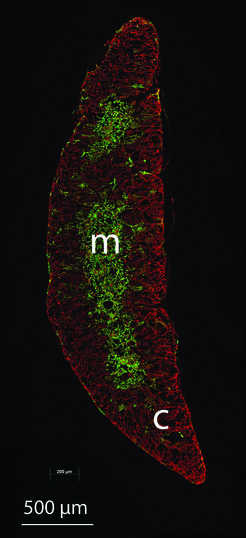Evolution & function of thymopoietic environments
Lab Boehm

Our previous evolutionary studies indicated that the Foxn1 transcription factor is a critical regulator of thymus development in all vertebrates. We hypothesized that during the early stages of vertebrate evolution, members of the Foxn4/Foxn1 gene family might have been coopted into a vertebrate-specific genetic network that resulted in the generation of a primordial thymopoietic microenvironment. We set out to characterize such primordial forms of the thymic microenvironment using a replacement strategy by swapping the mouse Foxn1 gene with representatives of the Foxn4/Foxn1 gene family isolated from animals occupying key positions in the vertebrate tree. The lymphopoietic capacities of these “replacement” lines suggest the possibility that the primordial vertebrate thymus might have supported both B and T cell development. Further evolution might have led to a preference for T cell differentiation at the expense of B cell development in the thymus, the latter phenomenon accompanied by the emergence of a plethora of extrathymic sites of B cell development (for instance, kidney in lower vertebrates; fetal liver and bone marrow in mammals). In-depth sequence comparisons of Foxn1/4 gene models suggested that the replacement of two exons in the vertebrate Foxn4 gene by a single exon of unrelated sequence might have been associated with the emergence of T cell preference of Foxn1-driven thymopoietic environments. Indeed, in the relevant Foxn4/1 chimaera, wherein the two Foxn4-derived exons are replaced by one Foxn1-derived exon, intrathymic B cell poiesis was lost, supporting the aforementioned evolutionary trajectory of Foxn4/1 gene family members.
In the thymus of the mouse replacement line expressing the FOXN4 gene of the basal chordate amphioxus, T‑cell development is supported, but only to the double-positive thymocytes stage of thymocyte development. The severe maturation block of T‑cells is associated with alterations in the transcriptional profile of transgenic TECs that are reminiscent of the situation encountered in a previous rescue experiment in which Foxn1 deficiency was complemented by expression of Cxc12 and Dll4 to achieve the intrathymic development of DP. We interpret this phenotype to indicate that – before the advent of somatic diversification of antigen receptor genes – Foxn1/4 paralogues lacked the capacity to direct a transcriptional programme conducive to central tolerance formation, such as MHC expression etc. This conclusion is supported by the observation of autoimmune phenomena in these mice, manifested by vitiligo, colitis, etc., accompanied by a shortened life-span.
Using lineage tracing and a conditional Foxn1 allele that can be reactivated by Cre recombinase, we have previously demonstrated that a single epithelial progenitor cell is capable of giving rise to a fully functional thymopoietic tissue in a self-organizing fashion and that this differentiation is Foxn1-dependent; in addition, we have shown that thymopoiesis in the mouse depends entirely on the Foxn1-positive cell lineage of thymic epithelial cells. Currently, this work is followed up by use of a novel CRISPR/Cas9-based lineage tracing system that can be read out at the RNA level.
